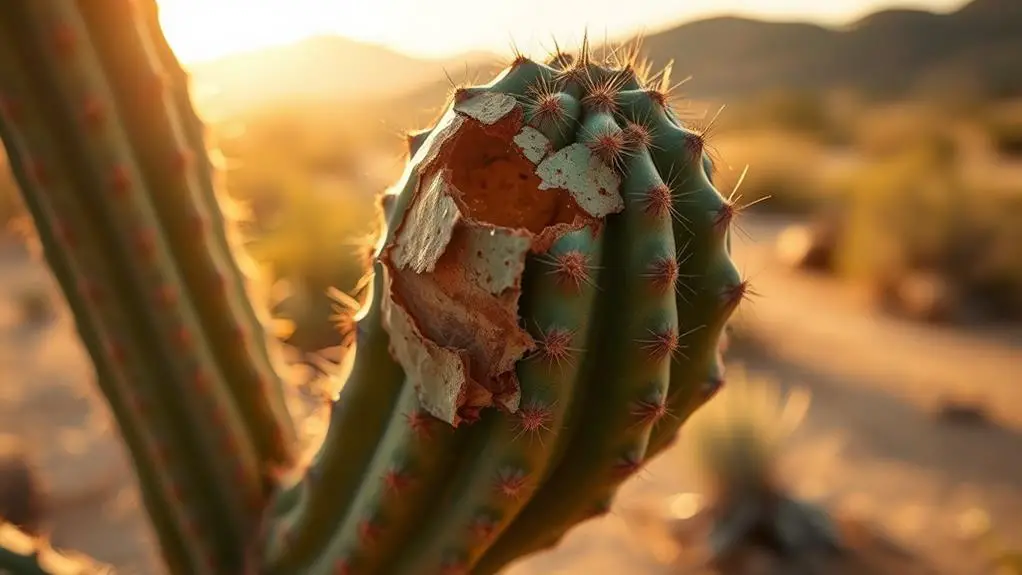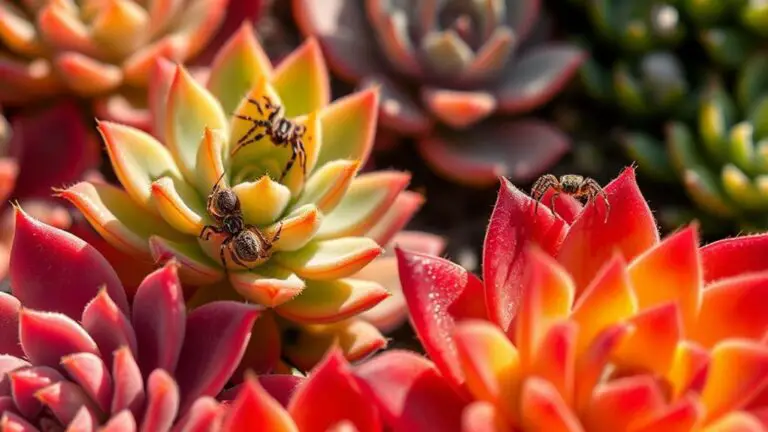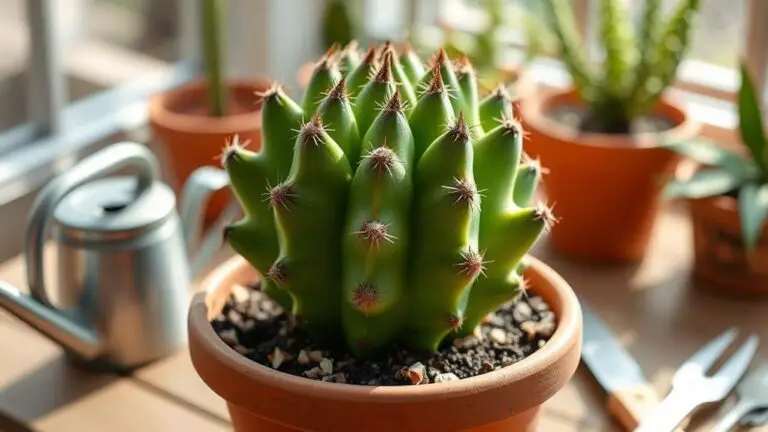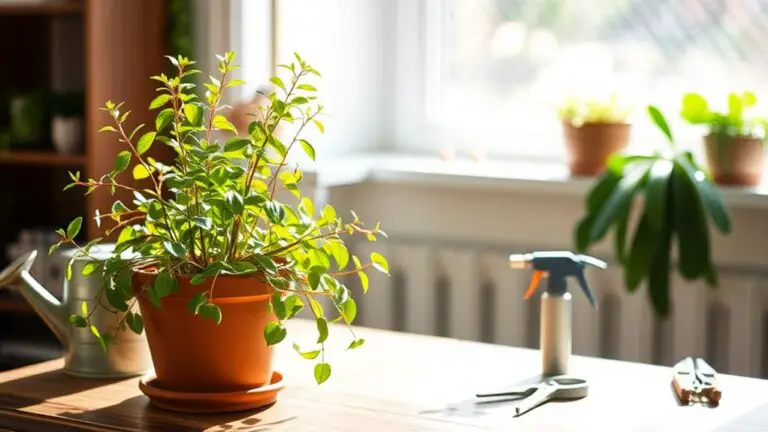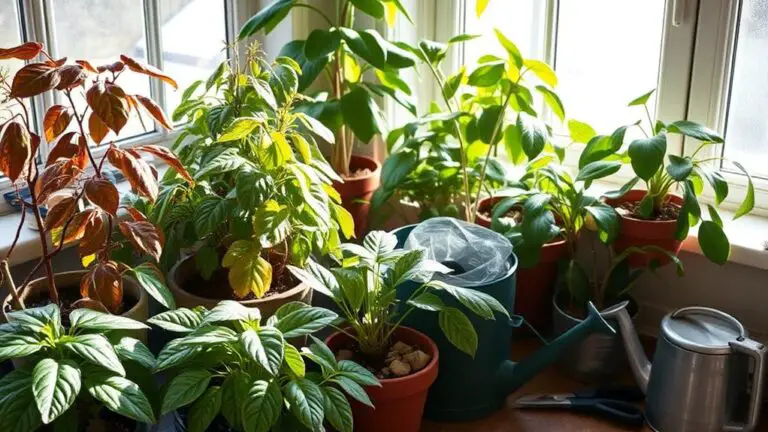Can a Damaged Cactus Heal Itself?
Have you ever wondered if a damaged cactus can heal itself? When your cactus suffers from scrapes, breaks, or even frost damage, it might seem like the end. However, much like human skin, cacti have their own ways of recovering. The extent of the damage and the season play vital roles in the healing process. Minor scrapes might resolve on their own, but significant injuries need a bit more attention, such as cleaning and fungicide application. So, what exactly does it take for a cactus to bounce back? Let's explore the techniques that can help your prickly friend recover.
The Short Answer
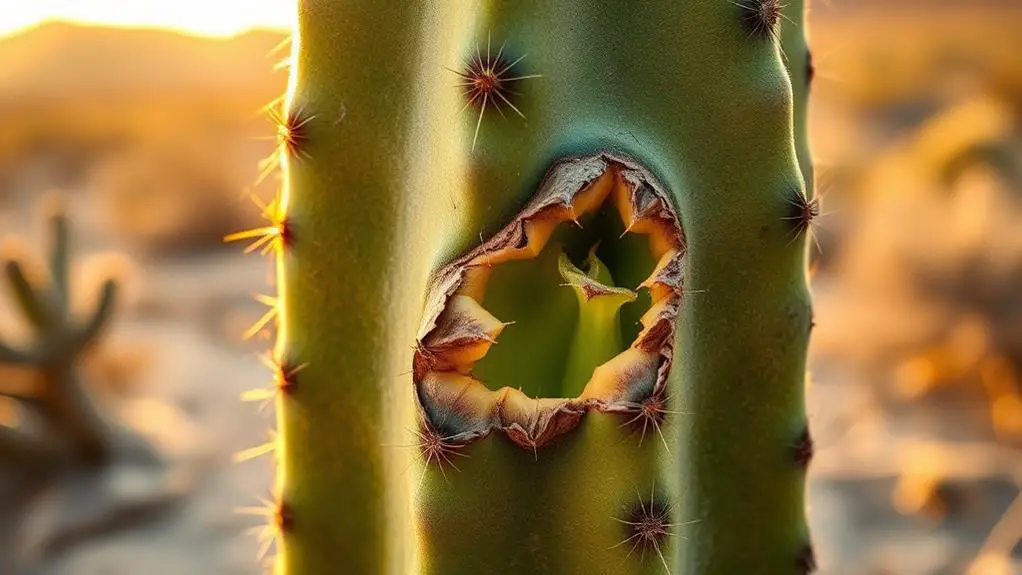
A damaged cactus can, indeed, heal itself over time. Just like how human wounds recover, cacti have the ability to mend their injuries. However, the speed and efficiency of this healing process can depend on several factors.
If your cactus gets hurt during its growing season, you're in luck. Plants like cacti have more nutrients and energy available during this time, which means they can heal quicker. But don't expect overnight miracles. Depending on the extent of the damage, it might take anywhere from a few weeks to several months for your cactus to fully recover.
Patience is key here. To help your cactus heal, make sure it gets plenty of bright, indirect sunlight. This is essential for its recovery.
Also, providing important nutrients will support the healing process. Just like any living thing, cacti need proper care to bounce back from injuries.
Types of Damage

When dealing with cactus damage, it's vital to understand the different types of injuries that can occur. Recognizing the nature of the damage helps you take the right steps to guarantee your cactus can heal effectively.
Here are some common types of cactus damage:
- Cuts: These are deeper injuries that might need cleaning and a fungicide to prevent infection. Without proper care, a cut can become a serious problem.
- Breakage: Major breakage, like when a part of the cactus snaps off, leads to slower recovery. The reattached parts mightn't look the same once they heal.
- Root Damage: Often happening during transplanting, root damage requires immediate pruning and care. This helps prevent further issues and promotes quicker healing.
- Frost Damage: You can identify frost damage by blackened, soft areas on the cactus. These areas need careful assessment and treatment to recover properly.
Addressing damage quickly is critical. Timely intervention can make all the difference in how well your cactus heals.
Understanding these types of injuries will empower you to provide the best care for your cactus, making sure it stays healthy and vibrant.
Scrapes and Scratches
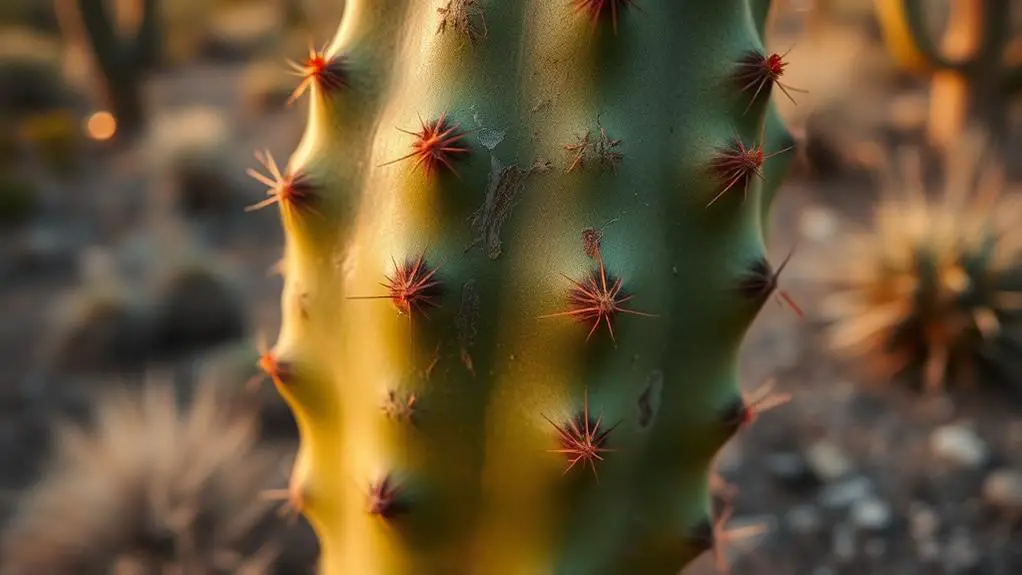
Over time, cacti can develop scrapes and scratches from various sources such as wildlife, accidental bumps, or even gardening tools. These minor injuries might look alarming, but don't worry! Shallow scrapes typically heal back naturally without your help. Just give them some time and keep an eye on them.
However, deeper cuts need immediate attention to prevent infection. First, clean the area gently with water. Then, apply a fungicide to keep harmful bacteria at bay. Doing this will give your cactus a better chance to heal back properly.
If the damage looks rough, you might need to use a sharp knife to smooth out the edges. Make sure the knife is clean to avoid introducing any bacteria. This will help the cactus heal back faster and more evenly.
During the healing process, place your cactus in bright, indirect sunlight. This light encourages recovery and growth. Regularly check on your cactus to monitor its progress and detect any early signs of infection.
You've got this! With a little care and attention, your cactus can bounce back from scrapes and scratches, staying healthy and strong.
Breakage
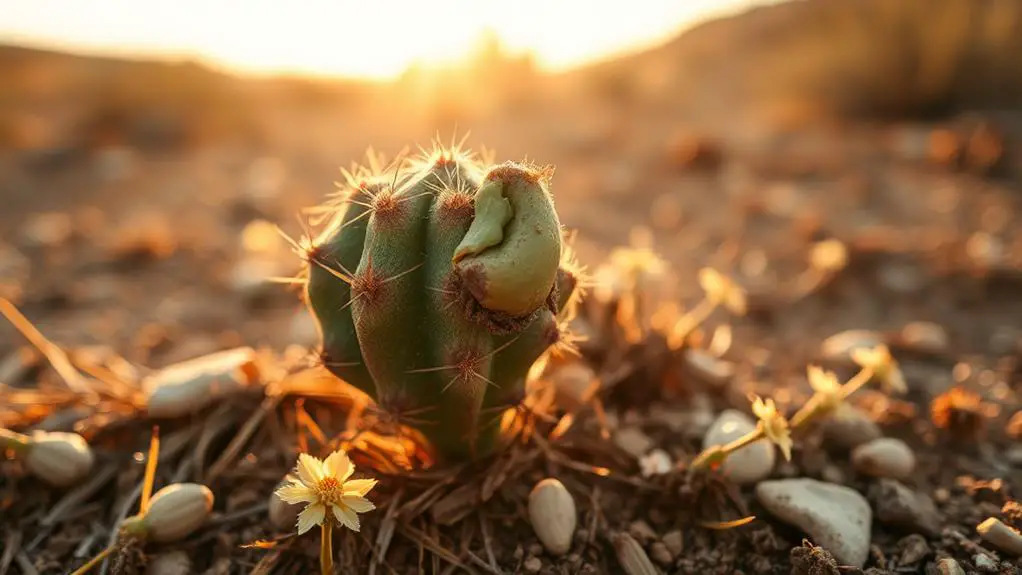
Breakage in cacti can be alarming, but don't panic. While your cactus mightn't look the same, it can still heal and even grow back stronger. When your cactus breaks, it's important to take swift action to guarantee the best recovery.
First, clean the cut end of the broken piece and the main plant. This helps prevent infection. Let both cut ends callous over for a few days. This step is essential because it seals the wound, reducing the risk of rot.
Once calloused, you can reattach or propagate the broken piece. Here are some key points to keep in mind:
- Clean and smooth wound areas: This guarantees better healing.
- Callousing: Let the cut ends dry out and harden before reattaching.
- Grafting season: Perform reattachment during the cactus's growing season.
- Monitor progress: Look for growth around the grafting string to know when to remove it.
Damaged Roots
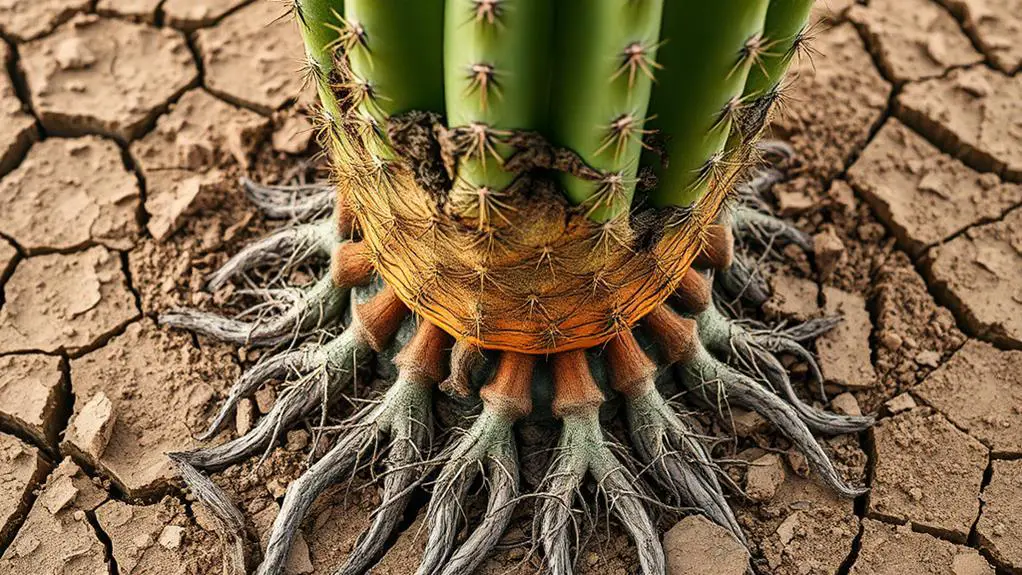
Handling breakage is just one aspect of cactus care; another significant issue to address is root damage.
Root damage often happens during transplanting and can lead to serious health issues if not dealt with quickly. When you repot your cactus, be careful to avoid damaging the roots. If you notice any signs of root rot, it's vital to prune the affected areas immediately. This helps stop the damage from spreading.
Start by removing the cactus from its pot and gently shake off the excess dirt. This allows you to see the roots clearly and assess the extent of the damage.
Once you've trimmed away any rotten parts, let the roots dry and callous over for a few days. This step is important for preventing future damage.
After the roots have dried, replant the cactus in well-draining soil and use a pot with drainage holes.
Regular care is essential for maintaining healthy plants. Be sure to water your cactus appropriately and monitor soil conditions regularly.
Frost Damage
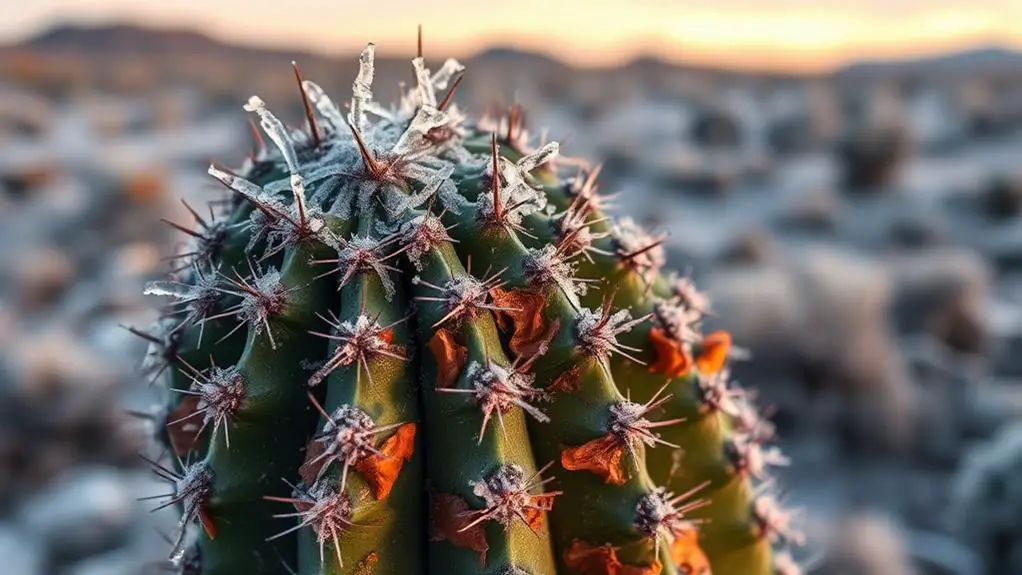
Frost damage in your cactus often shows up as black or soft spots, which means the plant's cells have been hurt by the cold.
To help your cactus recover, you need to cut away the damaged areas and make sure it gets plenty of bright, indirect sunlight.
For future protection, keep an eye on the weather and either cover your cactus or bring it inside when it gets too cold.
Identifying Frost Damage
When cold weather strikes, it's vital to recognize the signs of frost damage on your cacti to protect them from further harm. Frost damage typically shows up as blackened, soft spots on the cactus, signaling that the tissue has died due to freezing temperatures. These areas might become mushy and can lead to rot if not taken care of quickly.
Cacti have varying abilities to withstand cold, so those acclimated to warmer conditions are more at risk when exposed to low temperatures. Spotting frost damage early on is important because it allows you to take immediate action, such as trimming away the damaged parts to prevent rot from spreading.
Here are some key signs to look out for:
- Blackened patches: These are dead tissues caused by frostbite.
- Soft or mushy areas: Indicate that the cells have burst due to freezing.
- Discoloration: Look for unusual dark or water-soaked spots.
- Sagging or wilting: Damaged areas may lose their firmness and structure.
Steps for Recovery
To help your frost-damaged cactus recover, start by moving it to a warmer environment with bright, indirect sunlight. This change will encourage healing.
First, assess the extent of the damage. Blackened, soft areas indicate dead tissue that needs your immediate attention. If the damage is only superficial, your cactus may heal on its own. However, deeper damage requires more work.
Next, use a clean knife to cut away the damaged parts of the cactus. Make sure your knife is sharp and sterile to avoid causing more harm. Carefully trim the affected areas until you see healthy, green tissue. This step is essential as it prevents the spread of decay.
After trimming, apply a fungicide to the exposed areas. This will help prevent infections, which frost-damaged cacti are more prone to.
Be patient; the healing process can take weeks or even months, depending on the severity of the damage and the cactus's growing season.
Healing Techniques
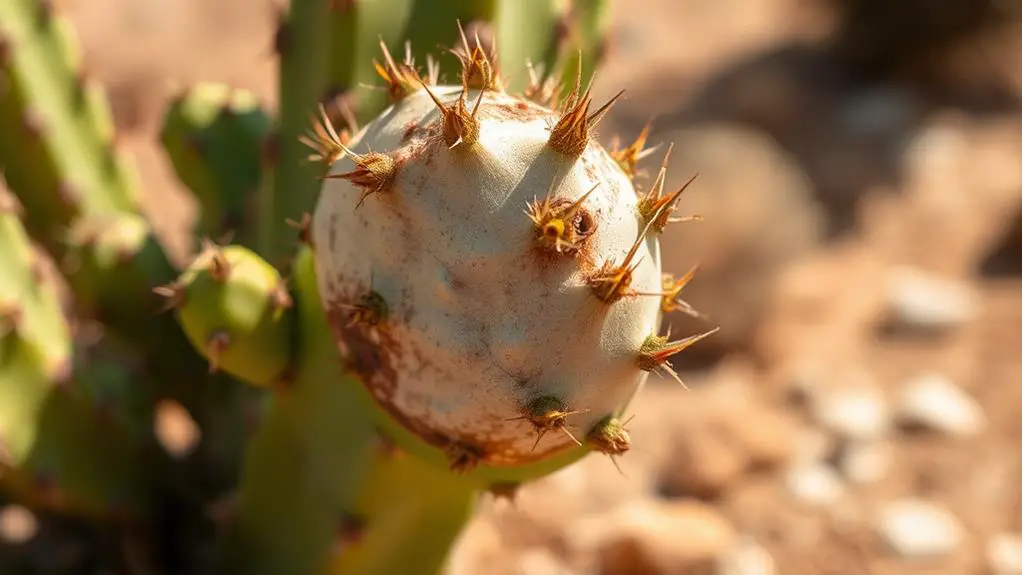
Healing techniques for a damaged cactus can make a significant difference in its recovery. First, for minor scrapes and scratches, your cactus can heal naturally. However, deeper cuts need extra care. Make a clean cut, then apply fungicide to prevent infection. This helps your cactus grow strong and healthy again.
If a piece of your cactus breaks off, you can reattach it through grafting. Grafting involves making clean cuts on both the main cactus and the broken piece, then securing them together with string. This promotes healing and allows the cactus to grow as one plant again.
Here are some additional tips to help your cactus recover:
- Allow broken limbs to callous for 2 days in a shady area before planting them.
- For root damage, prune the affected areas immediately and let the roots dry and callous before replanting.
- Monitor the healing process closely and provide bright, indirect sunlight.
- Keep your cactus in a well-ventilated area to prevent moisture buildup and rot.
Preventative Measures
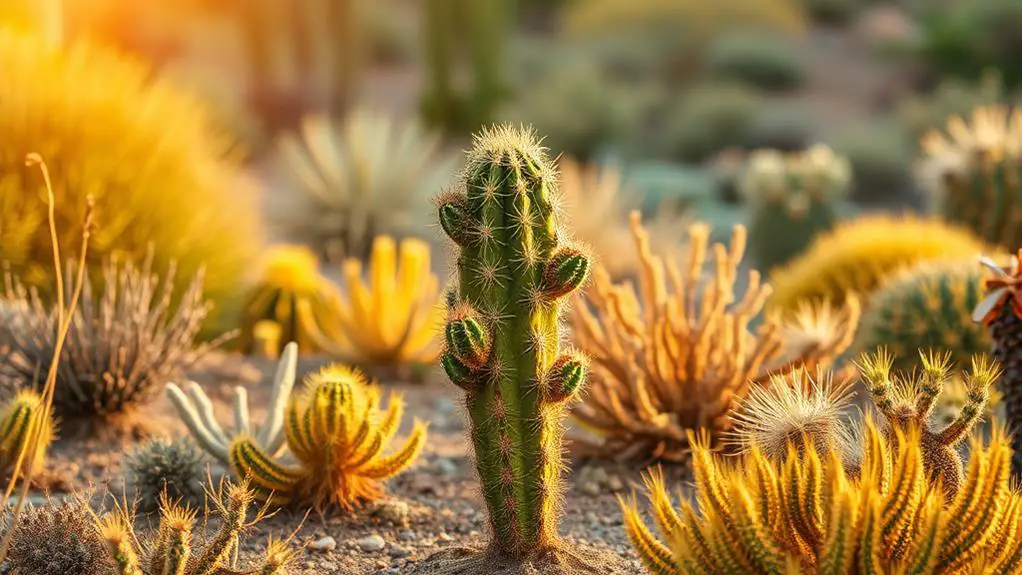
While healing techniques can help a damaged cactus recover, implementing preventative measures is the best way to avoid injuries in the first place.
To start, make certain your cactus has an adequately sized pot. This supports its weight and prevents tipping or breaking due to top heaviness. A sturdy pot keeps your cactus stable and safe from falls.
Next, consider using potassium sulfate. This strengthens the cactus stems, making them more resistant to breakage and helping them develop sturdier growth. Strong stems mean a healthier plant overall.
Regularly assess your cactus's health. Look for signs of instability, such as leaning or wobbling, and address them quickly to prevent falls and damage.
Adjust your watering and fertilization practices based on the cactus's growth stage. Overwatering or under-fertilizing can weaken the plant, making it more susceptible to injury.
Monitor environmental factors like light and temperature. Cacti thrive in specific conditions, and maintaining these helps reduce the risk of damage from external stresses.
By paying attention to these details, you'll create an ideal environment for your cactus.
Implementing these preventative measures guarantees your cactus remains healthy and resilient, reducing the need for healing down the road.
Frequently Asked Questions
How to Heal a Damaged Cactus?
First, assess the damage. Clean deeper cuts and apply fungicide. For broken pieces, make clean cuts and graft if needed. Prune damaged roots, let them dry, and replant. Allow wounds to dry and mist propagated pieces regularly.
How Long Does It Take for a Cactus Injury to Heal?
Healing time for a cactus injury varies. Scratches heal faster, especially during the growing season. Deeper cuts and major damage take longer and might need treatment. Root damage requires immediate care to avoid prolonged recovery.
Should I Cut off Dead Parts of Cactus?
You should cut off dead parts of the cactus. By doing this, you'll prevent disease spread, improve appearance, and promote better light and airflow. Use a sharp, clean knife and let the wound dry before replanting or watering.
Can You Save a Rotting Cactus?
Yes, you can save a rotting cactus. Act quickly by cutting away all infected areas with a disinfected knife. Let the wound dry in indirect light. Keep the soil slightly moist and monitor the cactus regularly.
Conclusion
With the right care, your damaged cactus can heal over time. Keep an eye on it, provide bright but indirect sunlight, and clean any wounds to prevent infection. It might take weeks or even months, but your cactus is resilient. Remember, patience is key. By monitoring its progress and giving it the right conditions, you'll help it recover. You've got this! Your cactus will thank you with new growth and vibrant health.

